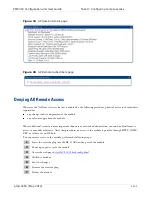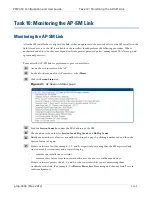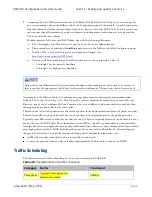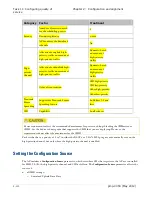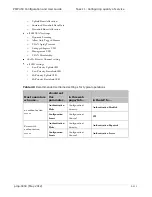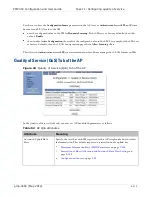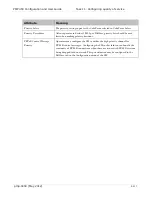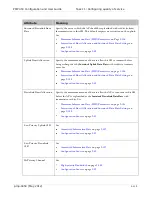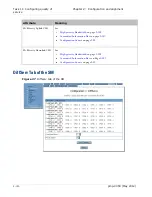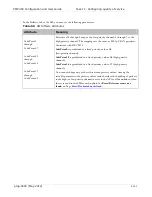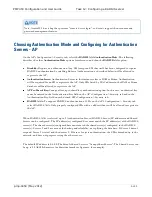
PMP 450 Configuration and User Guide
Task 11: Configuring quality of service
pmp-0050 (May 2012)
2-109
comparing the 6-bit Differentiated Services Code Point (DSCP) field in the ToS byte of a received packet
to a corresponding value in the Diffserv tab of the Configuration page of the module. A packet contains no
flag that indicates whether the encoding is for the Low Latency bit or the DSCP field. For this reason, you
must ensure that all elements in your trusted domain, including routers and endpoints, set and read the
ToS byte with the same scheme.
Modules monitor ToS bytes with DSCP fields, but with the following differences:
The 6-bit length of the field allows it to specify one of 64 service differentiations.
These correlate to 64 individual (
CodePoint
) parameters in the Diffserv tab of the Configuration page.
Per RFC 2474, 3 of these 64 are preset and cannot be changed. (See
http://www.faqs.org/rfcs/rfc1902.html
For any or all of the remaining 61 CodePoint parameters, you can specify a value of
o
0 through 3 for low-priority handling.
o
4 through 7 for high-priority handling.
Ensure that your Differentiated Services domain boundary nodes mark any entering packet, as needed, so
that it specifies the appropriate Code Point for that traffic and domain. This prevents theft of service level.
An example of the Diffserv tab in the Configuration page and parameter descriptions are provided under
on Page
. This tab and its rules are identical from module type to module type.
However, any of the 61 configurable Code Points can be set to a different value from module to module, thus
defining unique per-hop behavior for some traffic.
This tab in the AP sets the priorities for the various packets in the downstream (sent from the public network).
This tab in the SM sets the priorities for the various packets in the upstream (sent to the public network).
Typically, some SMs attach to older devices that use the ToS byte as originally formatted, and others to newer
devices that use the DSCP field. The
default
values in the Diffserv tab allow your modules to prioritize traffic
from the older devices roughly the same as they traditionally have. However, these default values may result in
more high-priority traffic as DSCP fields from the newer devices are read and handled. So, after making any
changes in the Diffserv tab, carefully monitor the high-priority channel for high packet rates
in SMs that you have identified as those to initially set and watch.
across your network when you have broadly implemented Code Point values, such as via SNMP.
Traffic Scheduling
The characteristics of traffic scheduling in a sector are summarized in
Table 48
Characteristics of traffic scheduling
Category Factor
Treatment
Throughput
Aggregate throughput, less
additional overhead
14 Mbps
Summary of Contents for PMP 450
Page 1: ...Cambium PMP 450 Configuration and User Guide System Release 12 0...
Page 6: ......
Page 22: ......
Page 172: ......
Page 173: ...PMP 450 Configuration and User Guide pmp 0050 May 2012 3 1 Chapter 3 Reference information...
Page 178: ......









